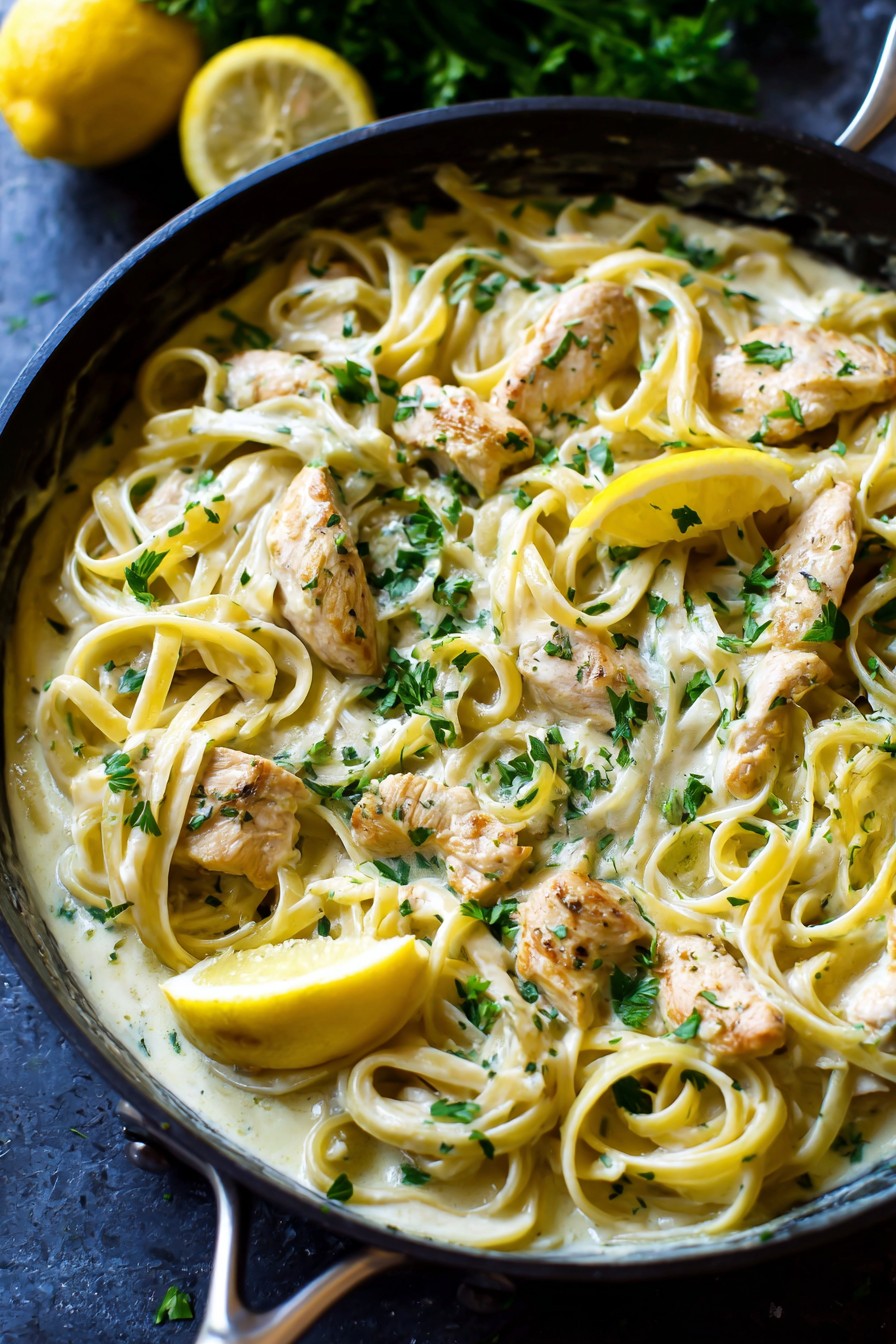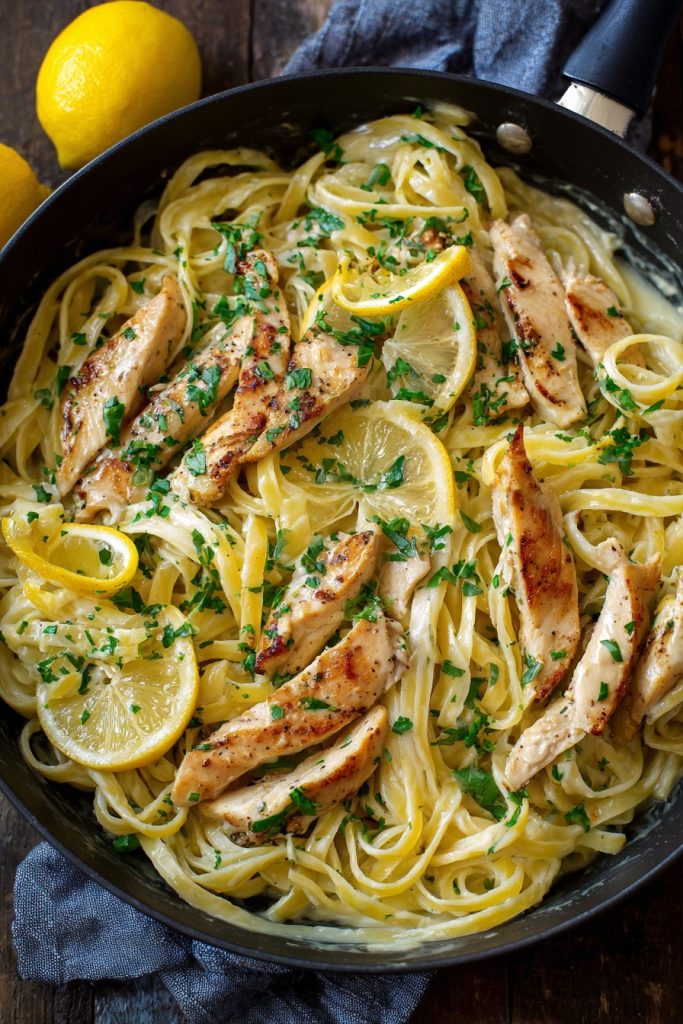Every busy weeknight deserves a hero dish that’s both lightning-fast and bursting with flavor, and this lemon chicken pasta is here to save the day with its bright, tangy sauce and tender, juicy chicken. Even better, it comes together in under 30 minutes, making it the perfect answer to those “what’s for dinner?” dilemmas without sacrificing an ounce of deliciousness.
Why This Recipe Works
- The combination of fresh lemon juice and zest creates a vibrant, citrusy sauce that cuts through the richness of the pasta and chicken, offering a refreshing balance that wakes up your taste buds.
- Searing the chicken breasts at a high temperature locks in juices and develops a golden-brown crust, ensuring each bite is moist and packed with savory flavor instead of dry and bland.
- Using starchy pasta water to emulsify the sauce helps it cling perfectly to every noodle, creating a silky, cohesive dish rather than a separated, oily mess.
- Fresh herbs like parsley add a pop of color and a burst of freshness at the end, elevating the dish from simple to restaurant-quality with minimal effort.
Ingredients
- 12 oz boneless, skinless chicken breasts, thinly sliced into 1/2-inch strips
- 8 oz linguine or fettuccine pasta
- 3 tbsp olive oil, divided
- 4 cloves garlic, minced
- 1/2 cup chicken broth
- 1/4 cup fresh lemon juice (from about 2 large lemons)
- 1 tbsp lemon zest
- 1/2 cup heavy cream
- 1/4 cup grated Parmesan cheese, plus extra for serving
- 2 tbsp unsalted butter
- 1/4 cup fresh parsley, chopped
- 1 tsp salt, divided
- 1/2 tsp black pepper
- 1/4 tsp red pepper flakes (optional)
Equipment Needed
- Large pot for boiling pasta
- Large skillet or sauté pan
- Measuring cups and spoons
- Chef’s knife and cutting board
- Zester or microplane
- Juicer or fork for lemons
- Tongs or slotted spoon
- Whisk
Instructions

Step 1: Cook the Pasta
Bring a large pot of generously salted water to a rolling boil over high heat—you want it as salty as the sea to season the pasta from within. Add the linguine or fettuccine and cook according to package directions until al dente, which typically takes about 9-11 minutes. Reserve 1 cup of the starchy pasta water before draining; this liquid gold will help create a luscious, emulsified sauce later. Drain the pasta but do not rinse it, as the starch on the surface is crucial for sauce adherence. Tip: Always taste a noodle a minute before the suggested cook time to ensure perfect al dente texture—it should have a slight bite without being crunchy.
Step 2: Sear the Chicken
While the pasta cooks, pat the chicken strips completely dry with paper towels—this is non-negotiable for achieving a proper sear. Season both sides evenly with 1/2 teaspoon salt and 1/2 teaspoon black pepper. Heat 2 tablespoons of olive oil in a large skillet over medium-high heat until shimmering but not smoking, about 2-3 minutes. Add the chicken in a single layer without overcrowding (work in batches if needed) and cook undisturbed for 3-4 minutes per side until deeply golden brown and the internal temperature reaches 165°F on an instant-read thermometer. Transfer to a plate and tent with foil to keep warm.
Step 3: Sauté the Aromatics
Reduce the heat to medium and add the remaining 1 tablespoon of olive oil to the same skillet. Add the minced garlic and red pepper flakes (if using) and sauté for 45-60 seconds until fragrant and lightly golden—be vigilant here, as garlic can burn in a flash and turn bitter. Pour in the chicken broth to deglaze the pan, scraping up all those flavorful browned bits from the chicken with a wooden spoon. Let it simmer for 1-2 minutes until slightly reduced, then stir in the fresh lemon juice and zest.
Step 4: Create the Creamy Lemon Sauce
Reduce the heat to low and whisk in the heavy cream and grated Parmesan cheese until smooth and fully incorporated. Add the butter and let it melt gently into the sauce, stirring constantly to prevent curdling. Simmer for 2-3 minutes until the sauce thickens slightly and coats the back of a spoon. If the sauce seems too thick, gradually add splashes of the reserved pasta water until it reaches your desired consistency—start with 1/4 cup and adjust from there. Season with the remaining 1/2 teaspoon salt and taste for balance, adding more lemon juice or pepper if needed.
Step 5: Combine and Serve
Add the drained pasta and seared chicken back to the skillet, tossing everything together with tongs until the noodles are evenly coated in the sauce and the chicken is reheated, about 1-2 minutes. If the mixture seems dry, add another 1/4 cup of pasta water to loosen it up. Remove from heat and stir in the chopped parsley for a fresh, herbal finish. Tip: Let the pasta sit for 2 minutes off the heat before serving—this allows the sauce to fully cling to the noodles. Serve immediately with extra Parmesan cheese on top.
Tips and Tricks
For the most vibrant lemon flavor, always use fresh lemons rather than bottled juice—the difference in brightness is night and day. Roll your lemons firmly on the counter before juicing to maximize yield, and zest them first to avoid bitter white pith. When slicing chicken, partially freeze it for 20 minutes to make thin, even strips easier to achieve. For extra tender chicken, consider marinating it in 2 tablespoons of lemon juice and 1 tablespoon of olive oil for 15-30 minutes before cooking, though this is optional for time-crunched nights. If you prefer a richer sauce, swap half the heavy cream for full-fat coconut milk for a subtle tropical twist, or use cream cheese softened at room temperature for added tang and thickness. To make this dish ahead, prepare the components separately: cook the pasta and store it tossed with a bit of oil to prevent sticking, keep the cooked chicken refrigerated, and make the sauce but hold off on adding the cream until reheating to avoid separation. When ready to serve, gently warm the sauce, stir in the cream, and combine everything over low heat. For a gluten-free version, use your favorite gluten-free pasta and ensure your chicken broth is certified GF. To boost veggie content, sauté sliced mushrooms, spinach, or asparagus along with the garlic—just add them after the garlic has fragranted and cook until tender. Finally, if you accidentally overreduce your sauce, don’t panic! Whisk in a bit more chicken broth or pasta water to thin it out without diluting flavor.
Recipe Variations
- For a seafood twist, substitute the chicken with 1 pound of large shrimp or scallops—sauté them for 2-3 minutes per side until opaque and add them at the end to prevent overcooking.
- To make it vegetarian, replace the chicken with 2 cups of sliced cremini mushrooms and use vegetable broth instead of chicken broth, cooking the mushrooms until golden before proceeding.
- Add a burst of color and sweetness with 1 cup of halved cherry tomatoes or sun-dried tomatoes—toss them in during the last minute of cooking to warm through.
- For a herbaceous upgrade, stir in 2 tablespoons of chopped basil or dill along with the parsley, or add a tablespoon of capers for briny punch.
- Make it spicy by increasing red pepper flakes to 1 teaspoon or adding a diced jalapeño with the garlic for those who love heat.
Frequently Asked Questions
Can I use a different type of pasta?
Absolutely! While linguine and fettuccine work wonderfully for holding the creamy sauce, you can substitute with spaghetti, angel hair, or even short shapes like penne or farfalle. Just adjust the cook time according to package directions and reserve that pasta water—it’s key for sauce consistency. Avoid overly delicate pasta like orzo, as it can become mushy, and steer clear of whole wheat versions if you’re not a fan of their nutty flavor competing with the lemon.
How do I store and reheat leftovers?
Store leftovers in an airtight container in the refrigerator for up to 3 days. To reheat, place in a skillet over low heat with a splash of chicken broth or water, stirring gently until warmed through—avoid the microwave, as it can make the pasta rubbery and the sauce separate. If the sauce looks oily, whisk in a teaspoon of lemon juice or cream while reheating to bring it back together. I don’t recommend freezing this dish, as the dairy-based sauce may grainy upon thawing.
What can I use instead of heavy cream?
For a lighter option, substitute half-and-half or whole milk, but be aware the sauce will be thinner—simmer it longer or add a slurry of 1 teaspoon cornstarch mixed with 1 tablespoon water to thicken. For dairy-free, canned coconut milk works beautifully and adds a subtle sweetness, or use unsweetened almond milk with a tablespoon of olive oil for richness. Avoid sour cream or yogurt, as they may curdle when heated.
Can I make this recipe ahead of time?
Yes, with a few tweaks! Cook the pasta and chicken separately, store them refrigerated, and prepare the sauce base without the cream—keep it in a jar. When ready to serve, reheat the sauce, whisk in the cream, and combine with warmed pasta and chicken. This method ensures the pasta doesn’t absorb all the sauce and the chicken stays tender. Allow everything to come to room temperature for 10 minutes before reheating to avoid temperature shock.
Summary
This lemon chicken pasta is a quick, flavorful dish featuring seared chicken, al dente pasta, and a creamy citrus sauce—perfect for busy nights yet impressive enough for guests.
Lemon Chicken Pasta
5
servings10
minutes20
minutesIngredients
Instructions
- 1 Cook pasta in salted boiling water until al dente, reserving 1 cup pasta water before draining.
- 2 Sear chicken in olive oil over medium-high heat until golden and cooked through, then set aside.
- 3 Sauté garlic and red pepper flakes, deglaze with broth, then add lemon juice and zest.
- 4 Whisk in cream and Parmesan, then butter, simmering until thickened.
- 5 Combine pasta and chicken with sauce, adding pasta water as needed, then stir in parsley and serve.



